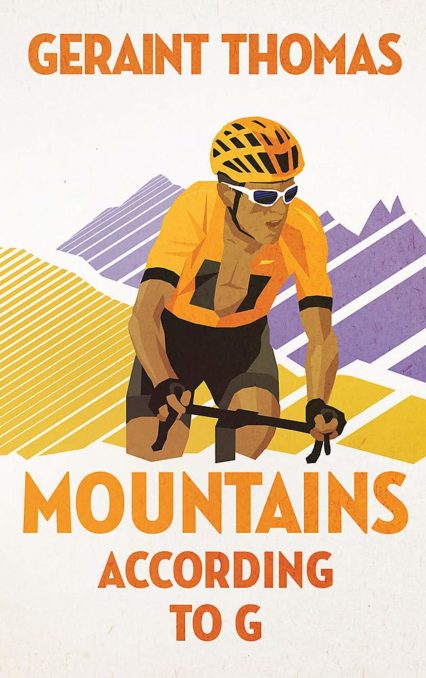Jim Morphy reviews Geraint Thomas’ Mountains According to G, the Welsh sporting-great’s guide to twenty-five of the world’s best cycling climbs.
“Thursday 19 July, 2018. 17.00 CET. After four and a half hours of bike-racing, including 4000 metres of ascent, Geraint Thomas started upwards on Alpe d’Huez. 13.8 kilometres lay ahead. 21 hairpin bends. 41 minutes of climbing. Up to a million spectators were on the hill that day. They covered the road, only parting a split-second before the cyclists were upon them. They screamed support and abuse. Some spat on Thomas, a member of the divisive Team Sky. Thomas rode most of the hill with rivals Tom Dumoulin, Romain Bardet, and team-mate Chris Froome. All were watching each other, waiting for another to attack, deciding when to attack. With 600 metres left, Mikel Landa – who had caught the lead group whilst they played cat and mouse – made his move. Thomas went with him, and overtook to take the stage win. Any lingering doubts about Thomas’ potential as a Tour winner were extinguished that day, on the most famous hill-climb of them all. Ten days after his show of strength, Thomas would ride up the Champs-Elysees as the first Welsh winner of the Tour de France. The mountains: where races are won and heroes are made.”
*
Mountains According to G, written with Tom Fordyce, is Geraint Thomas’ enjoyable account of riding upwards. Twenty-five mini-chapters each take on a particular hill, from the British climbs of Sunday-cycling lore to the epic ascents of the Grand Tours.

Thomas starts in Wales. Any local cyclist will relate to his account of working through the local climbs: ‘You cut your teeth on Rhigos. You make your name on the Bwlch. You establish it on the Tumble’. Within the hill portraits, Thomas gives insight into his career. The Cat and Fiddle, within striking distance of GB-cycling’s Manchester base, is identified as the hill on which Thomas learned his trade.
Thomas demonstrates a liking for oddball climbs. Some of the book’s most evocative passages take in ‘the mountains’ of Belgium and the Netherlands: sharp hills, often of cobbles, where positioning and bike-handling come to the fore. The Koppenberg – only 0.61 kilometres long and 78 metres high – is said to be the only climb you’ll see elite cyclists get off their bikes to push. Austria’s Solden and Italy’s Mortirolo are also written about with a heady mix of fear and awe.
Of course, the hills of the Tour de France take prominence. Thomas appears to prefer what he sees as the more characterful climbs of the Pyrenees and the Vosges over the functional – ‘wide roads, sensible roads’ – hills of the Alps. Thomas names the Col du Portet in the Pyrenees as the hardest climb he has ridden in Le Tour. It was after riding strong on this stage in 2018 that team-mate Froome took him to one side and said that he would now ride in Thomas’ service.
Despite Geraint Thomas’ natural disinclination towards tea-towel-famous climbs, he tells us that if we are to ride only two hills to make them Mont Ventoux and Alpe d’Huez. Roland Barthes wrote of Ventoux that it is ‘a god of Evil to which sacrifice must be made. A veritable Moloch, despot of the cyclists, it never forgives the weak and exacts an unjust tribute of sufferings’. It’s a shame that the fabled bald-mountain – that stands alone, although geologically part of the Alps – doesn’t have its own chapter in the book.
Thomas’ words on Alpe d’Huez emphasise the difference between the hill on a normal day and on a day of Le Tour. Outside of a week in July, it’s a ‘straight-laced businessman’ (an example of Thomas’ liking for jokey metaphors). Come Le Tour, it’s transformed into a chaotic party, which provides an occasion riders and spectators will never forget.
To ride the hill in the maillot jaune – taking in Dutch corner, Irish corner, and now a Welsh corner – must be as spectacular an experience as professional sport currently offers. That experience is reserved for the elite few, but Thomas is keen to encourage the reader to seek out these hills, seeing them as rare stadiums where the amateur can play where the professional does too. This approach allows the book to capture the pull of the mountains for weekend cyclists and pros alike. The pain and the glory. The ups and the downs.
It is unlikely that Mountains According to G will be picking up any of the big sports-book prizes. But it’s not attempting to be anything it’s not. Mountains is as unassuming as Thomas himself, for which credit must go to Fordyce. The voice of Geraint Thomas telling you tall stories in the pub shines through.
Released in late October, it will have made a perfect Christmas present for the cycling fan wanting a breezy read. Mountains does its job like a super-domestique.
Mountains According to G by Geraint Thomas and Tom Fordyce is available now from Quercus.
Jim Morphy is a critic and regular contributor to Wales Arts Review.
(Header image: Geraint Thomas is first to cross the finish line on the famed Alpe d’Huez. Credit: Marco Bertorello, AFP.)











